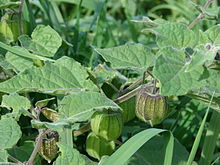| Physalis Temporal range: Early Eocene (Ypresian) to recent,
| |
|---|---|

| |
| Cape gooseberry (Physalis peruviana) leaves and fruit | |
| Scientific classification | |
| Kingdom: | Plantae |
| Clade: | Tracheophytes |
| Clade: | Angiosperms |
| Clade: | Eudicots |
| Clade: | Asterids |
| Order: | Solanales |
| Family: | Solanaceae |
| Subfamily: | Solanoideae |
| Tribe: | Physaleae |
| Genus: | Physalis L. (1753), nom. cons.[1] |
| Type species | |
| Physalis pubescens | |
| Species | |
|
About 75–90; see text | |
| Synonyms[2] | |
| |
Physalis (/ˈfaɪsəlɪs/, /fɪ-/, /faɪˈseɪlɪs/, /-ˈsæ-/, from φυσαλλίς : phusallís 'bladder'[3]) is a genus of approximately 75 to 90 flowering plants in the nightshade family (Solanaceae), which are native to the Americas and Australasia. At least 46 species are endemic to Mexico.[4] Cultivated and weedy species have been introduced worldwide. A defining feature of Physalis is a large, papery husk derived from the calyx, which partly or fully encloses the fruit.[5] Many species bear edible fruit, and some species are cultivated.
The typical Physalis fruit is similar to a firm tomato in texture, and like a sweet, tangy grape in flavor.[6] Some species, such as the Cape gooseberry and tomatillo, have been bred into many cultivars with varying flavors, from tart to sweet to savory. Nations including Colombia, India, and Mexico have a significant economic trade in Physalis fruit.[7] The fruits of many species are generically referred to as physalis, groundcherries,[8] husk tomatoes, husk cherries, poha berries, and golden berries.[9]
- ^ "Genus: Physalis L." Germplasm Resources Information Network. United States Department of Agriculture. 2009-09-01. Archived from the original on 2010-05-29. Retrieved 2010-04-14.
- ^ Physalis L. Plants of the World Online. Retrieved 24 April 2024
- ^ "Physalis | Definition of physalis in English by Oxford Dictionaries". Archived from the original on September 22, 2018.
- ^ Vargas, O.; et al. (2001). "Two new species of Physalis (Solanaceae) endemic to Jalisco, Mexico". Brittonia. 53 (4): 505–10. Bibcode:2001Britt..53..505V. doi:10.1007/bf02809650. S2CID 11564.
- ^ Whitson, M.; Manos, P. S. (2005). "Untangling Physalis (Solanaceae) from the physaloids: a two-gene phylogeny of the Physalinae". Systematic Botany. 30 (1): 216–30. doi:10.1600/0363644053661841. JSTOR 25064051. S2CID 86411770.
- ^ Morton JF (1987). "Cape gooseberry, Physalis peruviana L. in Fruits of Warm Climates". Purdue University, Center for New Crops & Plant Products.
- ^ Vargas-Ponce, Ofelia; Sánchez Martínez, José; Zamora Tavares, María del Pilar; Valdivia Mares, Luis Enrique (2016-12-01). "Traditional management of a small-scale crop of Physalis angulata in Western Mexico". Genetic Resources and Crop Evolution. 63 (8): 1383–1395. doi:10.1007/s10722-015-0326-3. ISSN 1573-5109. S2CID 41108248.
- ^ "Physalis". Integrated Taxonomic Information System. Retrieved 2011-05-21.
- ^ Doctor, Vikram (4 March 2013). "Golden berry: Decoding the acid freshness and wild sweet taste of physalis". The Economic Times. Archived from the original on November 10, 2013. Retrieved 6 Sep 2014.